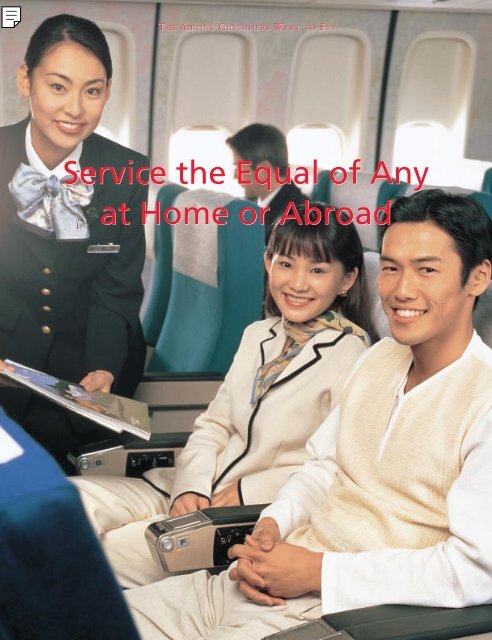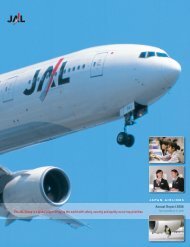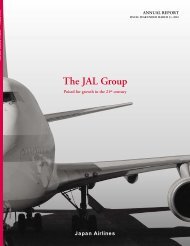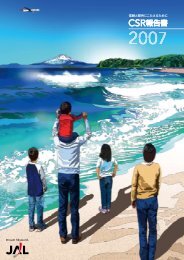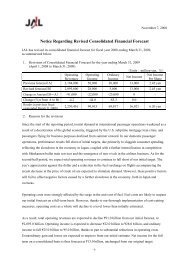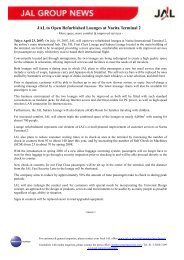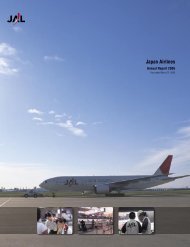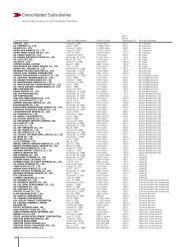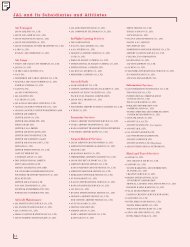JAL pdf - JAL | JAPAN AIRLINES
JAL pdf - JAL | JAPAN AIRLINES
JAL pdf - JAL | JAPAN AIRLINES
- No tags were found...
You also want an ePaper? Increase the reach of your titles
YUMPU automatically turns print PDFs into web optimized ePapers that Google loves.
T HE AIRLINE CUSTOMERS WANT TO FLYService the Equal of Anyat Home or Abroad6
T HE AIRLINE CUSTOMERS WANT TO FLYJapan Airlines aims at being the airline of choice for customers,providing attractive products that meet their needs,services that satisfy and a sense of security. These threeprecepts always guide our activity.Tie-up With American AirlinesJapan Airlines and American Airlines (AA) concluded acomprehensive alliance in 1994, and since then have deepenedtheir relationship in terms of business and service. InFebruary 1998, basic agreement was reached on a widerangingcode sharing tie-up to strengthen the alliance. Codesharing will actually begin from late 1998. At that initialstage, <strong>JAL</strong> flights from Japan to Los Angeles, New York andother nonstop destinations will use both <strong>JAL</strong> and AA flightnumbers. Conversely, AA flights to Japan from Dallas, Seattleand other cities will have <strong>JAL</strong> flight numbers. Thereafter, thesystem will be successively expanded. In the future, we expectto have code sharing flights to many destinations in the U.S.and Japan.Currently, the bulk of the code sharing <strong>JAL</strong> carries outwith other airlines covers at most 3 ~ 4 routes. This muchlarger alliance with AA takes full advantage of the networks ofboth companies. We anticipate that code sharing with AAwill ultimately embrace several hundred cities. This willenable both partners to offer a wide choice of routes andarrival and departure times.For the future, mega-alliances, including code-sharing tieups,are likely to create an era in which groups of airlinecompanies compete against one another. Recognizing thesignificance of this trend, Japan Airlines is drafting blueprintsfor alliance strategies in its home market. It is imperative thatThe Number of JapaneseTraveling Overseas(Millions)Years Ended December 3120151050’93 ’94 ’95 ’96 ’97Tourism Business OtherSource: Government white paper on travelThe Number of PassengersTraveling Overseas Via <strong>JAL</strong>,JAA and JAZ(Millions)Years Ended March 31151050’94 ’95 ’96 ’97 ’98In April 1998, the “AdvancePurchase Discount Goku 28”special fare was introduced.It is now in force for 10Pacific and 10 Asian routes.Basic agreement oncode-sharing wasreached in February1998 with long-timetie-up partnerAmerican Airlines.we look ahead to the upcoming age of global competition inthe next century and make decisions today accordingly.Establishing Fares Adapted to NeedsJust as consumer tastes are becoming more varied, the ways inwhich they travel are diversifying as well. Always dedicated toresponding quickly to such changes, <strong>JAL</strong> has introduced newfares to address these emerging needs.International travelers increasingly prefer independenttravel over group tours. We responded by introducing in thefiscal year ended March 1995 the “<strong>JAL</strong> Goku” fare, a type ofregular discount fare that was an immediate success. And inApril 1998, the “Advance Purchase Discount Goku 28” faresystem made its debut, targeting rising passenger demands forgreater discounts. Under this system, tickets purchased up to28 days prior to departure are eligible for fares even lowerthan “<strong>JAL</strong> Goku.” Currently, these new fares apply to 10Pacific and 10 Asian routes; <strong>JAL</strong> plans to extend these fares toother routes in accordance with demand.In April 1996, Japanese airlines were allowed to beginsetting domestic fares anywhere within a certain range. Thenew system quickly gained acceptance among passengers. Thenumber of passengers taking advantage of “Advance Purchase(MAEURI) Discounted 28” and other discounted fares hasgrown steadily. To build on this momentum, <strong>JAL</strong> unified twodiscount fare plans in September 1997: the “early morningticket,” offering a discount for early flights, and the “specialflight ticket,” which provides a discount for designated flights.At the same time, the number of flights on which thesediscounts are offered was increased by 9 to 44 to cover amuch larger area.7
T HE AIRLINE CUSTOMERS WANT TO FLYServices for the World TravelerOn the international routes, the main ongoing salespromotion campaigns are titled “Resócha,” “<strong>JAL</strong> DisneyCampaign” and “<strong>JAL</strong> EuroExpress.” All have been hugelypopular. In addition, we have expanded the areas covered byeach, enhanced relationships with the destination cities, andincreased the number of flights. These actions are makingthese campaigns even more effective. One example is theintroduction of “Night DE Resócha,” an overnight flightfrom Tokyo to Guam. And in November, Tokyo-Kona dailyservice was inaugurated.The international traveler is concerned with more thantime spent in the air. In recognition of this, <strong>JAL</strong> is movingforward with improvement of reservations and airportservices. During the fiscal year ended March 1998, we twiceexpanded the European areas covered by our Londonreservations office to embrace 9 countries — moves thatechoed a successful similar effort in the U.S. one year earlier.Not only has this enhanced the efficiency of our reservations;it has also enabled our staff to respond to passengers’ inquiriesin their own languages.Improving cabin services is a constant theme. Followingup the highly-rated <strong>JAL</strong> Executive Class – “SEASONS”service introduced last year, <strong>JAL</strong> launched “<strong>JAL</strong> Sky Sleeper”for first class. Passengers on long distance flights can sleep onnew electrically-powered seats that can recline to a completelyhorizontal position. Partitions, blankets and pillows are onhand, among other amenities to make a long flight a restfulone. This unique idea has been implemented since November1997 in first class on a total of 10 European and continentalU.S. routes, drawing kudos from travelers.“<strong>JAL</strong> Sky Sleeper”seats are installedin <strong>JAL</strong>’s firstclass cabins.Full flat seatsare now standardin first classfor long flights.Indexed Operating Costs PerAvailable Ton-Km(Non-Consolidated)Years Ended March 31100806040200’94 ’95 ’96 ’97 ’98(Note: 1994=100)Number of AXESSTerminals in Japan(Thousands)Years Ended March 31’94 ’95 ’96 ’97 ’98Expanding Domestic ServicesJapan Airlines continues to fill out its domestic network year byyear by establishing routes that maximize the potential of ourtakeoff and landing slots. New route selection also takes intoaccount costs, utilizing aircraft appropriate for demand, andmany other factors. In the fiscal year ended March 1998, anexpansion of slots at Haneda enabled <strong>JAL</strong> to commence serviceon 3 new routes. In addition, we were able to increase by onethe number of daily round-trip flights leaving Haneda for suchpopular destinations as Kumamoto, Oita and Kagoshima.Service has been expanded by the nationwide installation ofnew automatic check-in machines, an Internet ticketlessservice, improvement of the pushbutton telephone service andother innovations.In April 1997, moreover, we brought the <strong>JAL</strong> MileageBank into the domestic system, simultaneously pursuingvarious sales campaigns to make the Mileage Bank a coreservice for individual travelers.Japan Airlines’ basic concept for its domestic routesembraces “peace of mind, simplicity, convenience.” All threeare key to our growth in the gigantic domestic air travelindustry, which has about 82 million passengers each year.And these three elements are key to making <strong>JAL</strong> the airline ofchoice in an era wherein air travel is nothing special, but anordinary part of daily living.As a result of our ongoing sales promotions, the opportunitiesfor both individuals and groups to use <strong>JAL</strong> have steadilyrisen: in the fiscal year ended March 1998, domestic passengersincreased by 7.3 percent to 22.44 million.201510508
T HE AIRLINE CUSTOMERS WANT TO FLY9
T HE AIRLINE CUSTOMERS WANT TO FLYTaking Customer Satisfactionto the Nth Degree10
T HE AIRLINE CUSTOMERS WANT TO FLYRemaining “the airline of choice” — <strong>JAL</strong> recognizes thatthere is no other way to prevail in an era of yet stiffer competitionon an international scale. Enhancement of customersatisfaction (CS) has been the central theme of a ServiceCommittee. Established five years ago, the committee ischaired by the president and includes the senior officers incharge of services. To deepen and expand our commitment tocustomer satisfaction as central to management, the committeehas been reorganized as the CS Promotion Committee.This body provides a structure that reflects systematically theopinions and desires of our customers. Distinguishing thecommittee is its function as an ombudsman, providing adviceand counsel for the improvement of products and services.It has also been instrumental in revamping the sales,airport and passenger cabin service headquarters that createthe services directly encountered by customers. In addition,the committee has combined sales and airport functions intothe customer business division, and established a seamlessoverall system for providing services in line with customermovements.The Voice of the Customer as aManagement ResourceThe requests, praise, criticism and opinions of customers areevaluations of the services we offer, and indicators of serviceswe should be considering. At the same time as we hear thevoice of the customer, we seek to improve services at eachbranch. And services that draw customer praise are used toeducate employees, via CS information developed at themanagement level.Customers’ opinions are obtained via toll-free telephoneNumber of Employees (<strong>JAL</strong> Only)(Thousands)Years Ended March 312520151050’94 ’95 ’96 ’97 ’98Ground StaffCockpit CrewCabin CrewIn April 1997, ticketless servicewas added. It is available 24hours a day.lines, comment cards and other means. The number of theseresponses is growing every year: in the two years to March1997, they were up about 14 percent. In its in-flightmagazine Winds, <strong>JAL</strong> in turn provides feedback to passengerson actions taken in response to their suggestions. We are alsoplanning construction of a system for collecting the opinionsof employees who use <strong>JAL</strong> and other airlines for business orpersonal travel. This will enable us to reinforce our capabilitiesfor concrete evaluations of services.Furthermore, to heighten employee awareness ofcustomer satisfaction and promote improvements, the ServiceCommittee publishes a newsletter called Services Ratings(hyoban), which is distributed to all employees. We alsodistribute weekly the contents of electronic mail fromcustomers, centering on hints for upgrading services.The Family Serviceoffers special bedsfor infants and otheramenities for familytravelers.Physically-challengedpassengers are“Priority Guests,”issued with specialcards to enhanceconvenience.Inside the CabinThere are indispensable preconditions to being the airline ofchoice. To offer higher quality services, it is essential that werespond to the voice of the customer in a timely manner.Customer satisfaction is enhanced by addressing each of theirneeds. <strong>JAL</strong> is committed to improvement of all of its services,including those pertaining to the cabin or in-flight experience.Following through on thorough marketing research oncabin service, we have transformed passenger requirementsinto products. One example is adding value to the <strong>JAL</strong>Executive Class – “SEASONS” on international routes.Another is the introduction in December 1997 of the “<strong>JAL</strong>Sky Sleeper” seats in first class; these recline to a full-flatposition for a restful flight. In addition, service has beenrevamped in both its hardware and software aspects, all withthe passenger in mind.11
T HE AIRLINE CUSTOMERS WANT TO FLYFocus on Improving Safety12
T HE AIRLINE CUSTOMERS WANT TO FLYFor customers, by far the major reason for choosing an airlineis its safety. And for an airline, safety is its lifeline.Maintenance of safe flying is a permanent theme for<strong>JAL</strong>. We therefore believe that what is of utmost importancefor all employees, including those of the Group companies,is assuring the safe completion of every flight, one by one.This is not solely a matter for the flight and grounddivisions. Cabin safety, management of outsourced work,control of hazardous materials, security, and a myriad ofother functions are also essential. The core concepts for theGroup as a whole are “a different approach” and “improvesafety with this one step.”Safe and Comfortable Flying<strong>JAL</strong> has always taken an aggressive, problem-solving approachto cabin safety. One theme is preventing injuries to passengersand crew when turbulence is encountered. We have setup internal working groups, established clear rules for usingthe seat belt sign during turbulence and landings, andprepared educational materials for cockpit and cabin crews.Keying off the September 1996 occasion when a <strong>JAL</strong>emergency evacuation occurred at Narita, we created a studygroup to examine the best ways to guide passengers duringsuch emergencies. We will implement the group’s recommendationsas soon as possible after each idea one is submitted.Quality Control by Global StandardsThe key phrase for achieving safety in our cargo business is“handling hazardous materials.” To obtain the understandingof agencies and shippers, <strong>JAL</strong> adopts a proactive approach.To ensure safety,all employees workto promote thecompletion ofevery flightwithout incident.<strong>JAL</strong> tops the list foron-time departuresby aircraft type.This ratio is anindex of maintenancequality.Departure Reliability(%)B747 99.54B747-400 99.67B767 99.77DC-10 99.61MD-11 98.39B777 99.82B737-400 99.92Note: Departure reliability measures thehistorical probability of an aircraft’sdeparture not being canceled or delayedfor more than 15 minutes beyondschedule due to technical problems.And internally, improvement of quality control is pursued,including the handling of such materials. As the first stage inthis effort, in April 1998 <strong>JAL</strong>’s hub cargo branch at Naritaobtained ISO 9001 certification for its quality control.High Safety Levels<strong>JAL</strong>’s Engineering & Maintenance Division operates at theworld’s highest levels. A representative indicator ofmaintenance quality is seen in the 1996 on-time departureratios for the world’s major airlines — for the B747, B767,DC-10, MD-11, B737-400, B777 and other types of aircraft,<strong>JAL</strong> ranked among the leaders in each category. <strong>JAL</strong>’s Boeing777-200 operations have posted consistently high marks sincethis model was brought into service in April 1996. Followingon this success, the B777-300, whose fuselage is about 10meters longer than its B777-200 predecessor, entered domesticservice in July 1998. New aircraft require new knowledge,and the experience and data acquired from two years ofB777-200 operation have enabled smooth deployment of thenew equipment. For the B777, <strong>JAL</strong> has a cooperative maintenancearrangement with All Nippon Airways that will beextended to Japan Air System. This sharing of knowledge andexperience will enable the establishment of an effective maintenancesystem.As the cockpit crew plays a leading role in safety, <strong>JAL</strong> placesconsiderable priority on training flight crews. To maintain thehighest standards while implementing our managementstructural reform, we have increased use of simulators. Further,conscious of the fact that the contribution of the human factorto aircraft accidents is not diminishing, <strong>JAL</strong> began stressing theimportance of Cockpit Resource Management (CRM) adecade ago. Since June 1997, a head office CRM Committeehas been at work to clarify basic policy and rethink the overallcomposition of <strong>JAL</strong>’s CRM. Together with formulatingimportant programs, we are continuing to hone our CRMskills for the planned introduction in the fiscal year endingMarch 1999 of line flying operations.13


